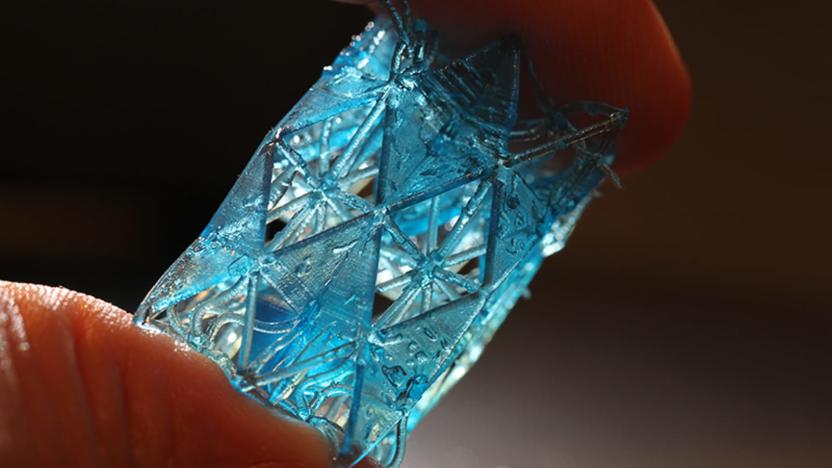Purdue University
Latest

Researchers are testing concrete that could charge your EV while you drive
Indiana is testing a new type of cement with embedded magnetized particles that could one day charge an EV while you drive.

Researchers create bone-inspired 3D-printed building materials
You may not think of your bones as buildings, but researchers do. A team from Cornell University, Purdue University and Case Western Reserve University believes that by studying the internal structure of bones, they may be able to 3D-print stronger construction materials for homes and buildings.

Starship's delivery robots now serve Purdue University
Starship's delivery robots have reached their largest school campus yet. Purdue students at the university's West Lafayette campus now have the option of ordering robot-delivered food that should arrive in "minutes." As at other schools, deliveries carry a flat $2 fee and work in tandem with your student meal plan. If you're too busy studying to traipse across the university grounds and don't want to spend much more than you're already paying for food, your solution might be at hand.

Researchers say 'spidey senses' could help self-driving vehicles avoid hazards
Researchers want to give cars, planes and drones "spidey senses." That is, they want to give autonomous machines sensors that mimic nature. In a paper published in ACS Nano, a team of researchers -- from Purdue University, Nanyang Technological University in Singapore and ETH Zürich -- propose integrating spider-inspired sensors into the exterior of autonomous machines. Doing so, they say, would allow vehicles to selectively process data faster than currently possible.

Physicists keep striking out in the search for dark matter
Space may be the final frontier, but we've barely begun to explore its underlying mechanics. For as much as humanity has discovered since we first looked to the heavens, we've only seen about five percent of the total matter in the universe. The other 95 percent -- the so-called "dark matter" -- well, we can't even figure out how to see yet. But that doesn't mean researchers from around the world aren't devising ways to do so.

ICYMI: Submersible sticky situations and elongating elastomer electrodes
Today on In Case You Missed It: Researchers from Purdue University and the Office of Naval Research teamed up to develop a new kind of glue that even works underwater. The synthetic compound is derived from proteins used by muscles to keep themselves attached to rocks. The man-made adhesive is 17 times stronger than its source material and could one day hold US Navy ships together. We also take a look at a stretchable electrode developed at Stanford University. Leveraging the same kind of molecule that commercial kitchens use to thicken soups, the Stanford researchers were able to develop an electrical conductor that can be easily deformed while actually conducting better as it is stretched. And finally, this is what happens when you hook a watermelon up to a car battery. As always, please share any interesting tech or science videos you find by using the #ICYMI hashtag on Twitter for @mskerryd.

Putting a virtual nose on video games could reduce simulator sickness
Virtual reality can be nauseating. It tricks a part of the brain into believing the body is moving, when it's not. A disconnect between the systems (somatosensory and vestibular, to be precise) can make some people want to throw up. But an ongoing study at Purdue College of Technology suggests that a virtual nose could reduce simulator sickness in video games. When your movement isn't anticipated by the body's perceptual system, it triggers motion sickness. That explains why it's usually a passenger who gets sick in a moving car and not the person driving the car.

Amazon takes on textbook sales at major universities
Amazon is set to open distribution centers at two large US colleges and offer students next-day delivery of textbooks and other items through co-branded websites. The universities of Massachusetts Amherst and Purdue say that the deal means students will save nearly $400 annually on textbooks. Amazon is also giving the schools a 0.5-2.5 percent cut, which will net at least $1.7 million in revenue for Purdue and $1.5 million for UMass over four years, according to the WSJ. The Amazon distribution center will completely replace the UMass textbook annex, currently operated by educational specialist Follett. That store will no longer carry course materials, but will continue to sell computers, clothing and other items.

Researchers build optical transistor out of silicon, provide path to all-optical computing
The speed of light is the universal speed limit, so naturally, optical technologies appeal when trying to construct speedy computational devices. Fiber optics let us shoot data to and fro at top speed, but for the time being our CPUs still make their calculations using electronic transistors. Good news is, researchers from Purdue University have built an optical transistor out of silicon that can propagate logic signals -- meaning it can serve as an optical switch and push enough photons to drive two other transistors. It's constructed of a microring resonator situated next to one optical line that transmits the signal, and a second that heats the microring to change its resonant frequency. The microring then resonates at a specific frequency to interact with the light in the signal line in such a way that its output is drastically reduced and essentially shut off. Presto, an optical transistor is born. Before dreams of superfast photonic computers start dancing in your head, however, just know they won't be showing up anytime soon -- the power consumption of such transistors is far beyond their electronic counterparts due to the energy inefficient lasers that power them.

Study: free apps drain 75 percent more power, badly built advertising to blame
It's often said there's no such thing as a free lunch and that's doubly the case for free apps. A team from Purdue University found that nearly three quarters of the power used when you run an app like Angry Birds is actually used for adverts. It developed eprof, an app that investigates what processes are draining from your battery. Loading it onto the very old-school Android-powered myTouch 3G and Nexus One (not to mention a HTC TyTn II running Windows Mobile 6.5). Drilling down into those Angry Birds figures: the game itself only consumes 18 percent of the power, while advertising platform Flurry has 45 percent and GPS location tracking a further 15 percent. Project leader Abhinav Pathak lays the blame at the feet of poorly coded apps that need to be made significantly more efficient. He's now working with Microsoft to bring his software to Windows Phone and will present his findings at the EuroSys conference in Bern next month. If you don't think you'll be able to give up free apps, just remember to shut down GPS before you start smashing those pigs.

Ghost Pedal: the virtual wah pedal that Rock Band wishes it had (video)
Jimi would be proud. Eight Purdue University students have concocted what's being dubbed a Ghost Pedal; for all intents and purposes, it's a sensor-based processor that's worn around the ankle of the player, and it enables wah-like effects to be commanded from anywhere on stage. Specifically: "The variable resistor sensor records what the user is doing with their ankle, and a sustain sensor either accepts the transmission feed or ignores / sustains it." We're also told that once it's turned on, the user enters a 10-second mode during which the variable resistor calibrates the ability to flex the foot from the floor in a normal pedal motion; after calibration mode, the guitarist enters freeplay mode. As of now, it's available for licensing, and there's a video just past the break to help you make up your mind.

Purdue University creates 'bass' powered medical implant, knows where it hertz
We've seen all kinds of medical implants over the years, but none that had a musical preference -- until now. Researchers at Purdue University have created a pressure sensitive microelectromechanical system (MEMS) that uses sound waves as an energy source. The proof-of-concept has a vibrating cantilever that's receptive to sound -- or music -- in the 200 - 500Hz frequency spectrum, which is towards the bottom end of the audible range. The subcutaneous implant converts the low-frequency vibrations into energy, and then stores it in a capacitor. Once the cantilever stops vibrating, it sends an electrical charge to a sensor and takes a pressure reading, the result is then transmitted out via radio waves for monitoring purposes. The immediate real world applications include diagnosing and treating incontinence, but we're already wondering if that self-powering mp3 player implant could finally become a reality?

This electric wire is four atoms thick, and you thought speaker cable was fiddly (video)
This should come as a great relief to anyone planning a quantum computer self-build: wires still conduct electricity and obey key laws of classical physics even when they're built at the nanoscale. Researchers at Purdue and Melbourne universities used chains of phosphorus atoms inside a silicon crystal to create a wire that's just four atoms wide and a single atom high -- 20 times smaller than the previous record-holder and infinitely narrower than anything you'd find at Newegg. The video after the break almost explains how they did it.

Ferroelectric transistor memory could run on 99 percent less power than flash
We've been keeping an optimistic eye on the progress of Ferroelectric Random Access Memory (FeRAM) for a few years now, not least because it offers the tantalizing promise of 1.6GB/s read and write speeds and crazy data densities. But researchers at Purdue University reckon we've been looking in the wrong place this whole time: the real action is with their development of FeTRAM, which adds an all-important 'T' for 'Transistor'. Made by combining silicon nanowires with a ferroelectric polymer, Purdue's material holds onto its 0 or 1 polarity even after being read, whereas readouts from capacitor-based FeRAM are destructive. Although still at the experimental stage, this new type of memory could boost speeds while also reducing power consumption by 99 percent. Quick, somebody file a patent. Oh, they already did.

Purdue University grad students give NASA lander tech a boost, do it for the experience
We just learned of NASA's end-of-decade plans to rocket astronauts into deep space for exploratory missions to Mars and beyond. Now, we're getting a peek at the Purdue University-designed lander tech that'll plant our space fleet's feet firmly on terra incognita. What originally started as a senior research project for grad students Thomas Feldman and Andrew Rettenmaier, has now blossomed into a joint research endeavor for the federal space agency's Project Morpheus -- a think tank for trips to heretofore unexplored celestial bodies. The in-development propulsion tech, now undergoing testing at the university's Maurice J. Zucrow Laboratories, is required to "meet stringent design and performance" standards, but most importantly, needs to lift the fuel-depleted lander post-descent. You'd think scientific work of this magnitude would come with a hefty paycheck, but the student team behind it all's just doing it for the hands-on knowledge. Sure beats your summer internship at that magazine, huh?

Ultra-pure material lets electrons discover each other on the quantum dance floor
These guys aren't Purdue University professors, they're DJs. That thing on the left? It isn't a high-mobility gallium-arsenide molecular beam epitaxy system, it's their decks. It creates an ultra-pure material so perfectly latticed that it traps electrons between its layers and stops them bouncing around like drunken fools at the high school prom. By squeezing them ever so tightly, it lulls the particles into an "exotic" slow dance, at which point they become "aware" of each other and start performing correlated motions that are essential for quantum computing. That's a still a long way off, but if one day we find ourselves affixing gallium arsenide swabs to our quantum motherboards, we'll raise our lighters in the air. Informative PR after the break.

Purdue's Celeritas car scores 2,200MPG from the sun, wins Shell Eco-marathon
With gas prices topping $4.50 per gallon in some parts of the country, a car that costs a fraction of a penny per mile to drive (and looks like it belongs on the road) is sure to get our attention. The 275-pound, 2,200MPG Celeritas appears to be the closest we've come to having a solar-powered car that could one day take to the streets, however, which explains why the vehicle scored first prize in the Urban Concept category in this year's Shell Eco-marathon. While it can only transport a single person (the driver), the car includes headlights, taillights, a trunk and even backup cameras. Notably absent from this version are air conditioning and a license plate -- the latter of which would (naturally) be required before the car becomes street legal. The Purdue University design team chose "Celeritas" (Latin for "swiftness") as the name for this soon-to-be-street-legal roadster, though in a category that's notorious for slower vehicles, we wouldn't expect the prototype to fly past us in the fast lane. Perhaps we can get Celeritas and IVy together for some alone time before we're dropping Hamiltons for a gallon of regular?

Rube Goldberg Machine to set new world record, bring forth apocalypse
If you've never seen the rise and fall of humanity as told by a series of pulleys, levers, and CO2 rockets, now's your chance -- a team of Purdue engineers have built a contraption that not only tells the history of the world through the end of days, but is also a contender for the world's largest Rube Goldberg machine. The Purdue team's "Time Machine" catalogs a history of dinosaurs, war, and rock 'n roll before finally culminating in a cataclysmic inferno and efflorescent renewal in 232 steps -- narrowly beating out the previous record of 230 set by Ferris State University in 2010. Impressive, but not officially the "world's largest" just yet-- the team is submitting a video of a flawless run to Guinness World Records to certify the historic thingamajig, hopefully eking out a victory with its two step lead.

Purdue researchers make solar cell manufacturing cheaper, more efficient with lasers
Is there anything lasers can't do? We only ask because they seem to be improving everything from microphones to railroads, and now researchers from Purdue University have leveraged the power of light to better manufacture solar cells. Using an ultrashort (as in quadrillionths of a second) pulse laser to more precisely scribe the microchannels connecting thin-film solar cells -- as compared to current mechanical stylus methods -- the Boilermakers were able to improve energy transfer efficiency between cells and significantly reduce manufacturing time. Having demonstrated the process works, research continues to better understand and prepare it for use by manufacturers -- sooner rather than later, we hope.

Team at Purdue University working on high-temp generators to suck power from car exhaust
You know all that gas spitting out the exhaust of your car? Not only is it full of carbon monoxide and other things you shouldn't breathe, it's also full of heat. Heat is wasted energy, and students at Purdue University, led by mechanical engineering professor Xianfan Xu, are working to capture it. With some funding from General Motors the team is working to create better thermoelectric generators, or TEGs, that work at much higher temperatures than those we've seen before. A current Purdue prototype works at 700C, or 1,300F, which could be found behind a car's catalytic converter and generate enough electricity to reduce fuel consumption by around five percent. Future versions would work at higher temperatures and offer better results. Last year BMW indicated it is working on similar tech with deployments coming as early as 2014, and so now the race begins, though the culmination of their efforts will surely look something like this.













